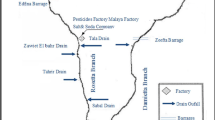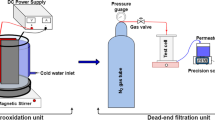Abstract
Water reclamation has become a feasible option due to water scarcity in many regions of the USA. Industrial fresh produce processing wastewater streams usually do not actively employ water recycling despite the large quantities of water being consumed. Further, there is a paucity of information on water reuse options for this sector. Therefore, this study assessed selected treatment processes for washwater from vegetable processing. The work focused on turbidity, chemical oxygen demand, dissolved organic carbon at ambient and low-temperature vegetable processing environments (4 °C). Microfiltration, ultrafiltration, reverse osmosis, and novel biocatalyst composites were evaluated using both synthetic washwater and composite washwater samples collected from a commercial produce processing plant. Results showed that ultrafiltration and microfiltration were able to substantially reduce turbidity, but achieved only minimal chemical oxygen demand and dissolved organic carbon reduction. A majority of the constituents contributing to these two parameters were dissolved compounds, causing challenges for physical separation treatment techniques. The biocatalyst system demonstrated good efficiency at both 22 and 4 °C, with respect to the removal of chemical oxygen demand (72 and 66%, respectively), and dissolved organic carbon (74 and 70%, respectively). Reverse osmosis generated high-quality water that could be employed in vegetable production line; however, extensive pretreatment processes were required. This study demonstrated the potential to recover washwater in produce processing industry. Moreover, the results showed that the biocatalyst treatment could be applied at low temperature and potentially applied to water recycling schemes for wastewater streams from food industries that operate under low operating temperatures.








Similar content being viewed by others
References
APHA-AWWA-WEF (2012) Standard methods for the examination of water and wastewater, 22nd edn. APHA-AWWA-WEF, Washington
Bassin JP, Kleerebezem R, Dezotti M, van Loosdrecht MCM (2012) Simultaneous nitrogen and phosphate removal in aerobic granular sludge reactors operated at different temperatures. Water Res 46:3805–3816
Casani S, Knøchel S (2002) Application of HACCP to water reuse in the food industry. Food Control 13:315–327
Casani S, Rouhany M, Knøchel S (2005) A discussion paper on challenges and limitations to water reuse and hygiene in the food industry. Water Res 39:1134–1146
Daufin G, Escudier JP, Carrère H, Bérot S, Fillaudeau L, Decloux M (2001) Recent and emerging applications of membrane processes in the food and dairy industry. Food Bioprod Process 79:89–102
De Kreuk M, Heijnen J, Van Loosdrecht M (2005) Simultaneous COD, nitrogen, and phosphate removal by aerobic granular sludge. Biotechnol Bioeng 90:761–769
D’Souza NM, Mawson AJ (2005) Membrane cleaning in the dairy industry: a review. Crit Rev Food Sci Nutr 45:125–134
Farizoglu B, Uzuner S (2011) The investigation of dairy industry wastewater treatment in a biological high performance membrane system. Biochem Eng J 57:46–54
Fritzmann C, Löwenberg J, Wintgens T, Melin T (2007) State-of-the-art of reverse osmosis desalination. Desalination 216:1–76
Gur-Reznik S, Katz I, Dosoretz CG (2008) Removal of dissolved organic matter by granular-activated carbon adsorption as a pretreatment to reverse osmosis of membrane bioreactor effluents. Water Res 42:1595–1605
Herzberg M, Elimelech M (2007) Biofouling of reverse osmosis membranes: role of biofilm-enhanced osmotic pressure. J Membr Sci 295:11–20
Howitt R, Medellín-Azuara J, MacEwan D, Lund J, Sumner D (2014) Economic analysis of the 2014 drought for California agriculture. In Prepared for California Department of Food and Agriculture by UC Davis Center for Watershed Sciences and ERA Economics
Kumar M, Badruzzaman M, Adham S, Oppenheimer J (2007) Beneficial phosphate recovery from reverse osmosis (RO) concentrate of an integrated membrane system using polymeric ligand exchanger (PLE). Water Res 41:2211–2219
Lehto M, Sipilä I, Alakukku L, Kymäläinen H-R (2014) Water consumption and wastewaters in fresh-cut vegetable production. Agric Food Sci 23:246–256
Luo Y, Nou X, Millner P, Zhou B, Shen C, Yang Y, Wu Y, Wang Q, Feng H, Shelton D (2012) A pilot plant scale evaluation of a new process aid for enhancing chlorine efficacy against pathogen survival and cross-contamination during produce wash. Int J Food Microbiol 158:133–139
Malaeb L, Ayoub GM (2011) Reverse osmosis technology for water treatment: state of the art review. Desalination 267:1–8
Mannapperuma J (1997) Design and performance evaluation of membrane systems. Handbook of food engineering practice, 167–210
Markus MR, Deshmukh SS (2010) An innovative approach to water supply—the groundwater replenishment system. World environmental and water resources congress, pp 3624–3639
Maupin MA, Kenny JF, Hutson SS, Lovelace JK, Barber NL, Linsey KS (2014) Estimated use of water in the United States in 2010. US Geological Survey
Mavrov V, Bélières E (2000) Reduction of water consumption and wastewater quantities in the food industry by water recycling using membrane processes. Desalination 131:75–86
Nelson H, Singh R, Toledo R, Singh N (2007) The use of a submerged microfiltration system for regeneration and reuse of wastewater in a fresh-cut vegetable operation. Sep Sci Technol 42:2473–2481
Ölmez H (2013) Water consumption, reuse and reduction strategies in food processing. Sustainable food processing. Wiley, Hoboken, pp 401–434
Ottoson J, Hansen A, Björlenius B, Norder H, Stenström TA (2006) Removal of viruses, parasitic protozoa and microbial indicators in conventional and membrane processes in a wastewater pilot plant. Water Res 40:1449–1457
Rabiller-Baudry M, Bégoin L, Delaunay D, Paugam L, Chaufer B (2008) A dual approach of membrane cleaning based on physico-chemistry and hydrodynamics: application to PES membrane of dairy industry. Chem Eng Process 47:267–275
Razavi-Shirazi F, Dorri MA, Dorri-Nowkoorani F, Razavi A (2013) Novel biocatalyst compositions and processes for use. Google Patents
Rockström J, Falkenmark M, Karlberg L, Hoff H, Rost S, Gerten D (2009) Future water availability for global food production: the potential of green water for increasing resilience to global change. Water Resour Res 45:W00A12
Rost S, Gerten D, Bondeau A, Lucht W, Rohwer J, Schaphoff S (2008) Agricultural green and blue water consumption and its influence on the global water system. Water Resour Res 44:W09405
Shen C, Luo Y, Nou X, Bauchan G, Zhou B, Wang Q, Millner P (2012) Enhanced inactivation of salmonella and pseudomonas biofilms on stainless steel by use of T-128, a fresh-produce washing aid, in chlorinated wash solutions. Appl Environ Microbiol 78:6789–6798
Sperlich A, Warschke D, Wegmann C, Ernst M, Jekel M (2010) Treatment of membrane concentrates: phosphate removal and reduction of scaling potential. Water Sci Technol 61:301–306
Suárez A, Fidalgo T, Riera FA (2014) Recovery of dairy industry wastewaters by reverse osmosis. Production of boiler water. Sep Purif Technol 133:204–211
Tchobanoglous G, Burton FL, Stensel HD (2002) Wastewater engineering, treatment and reuse. Metcalf and Eddy, 4th edn. McGraw-Hill, London
Van Haute S, Uyttendaele M, Sampers I (2015) Coagulation of turbidity and organic matter from leafy-vegetable wash-water using chitosan to improve water disinfectant stability. LWT Food Sci Technol 64:337–343
Weng S, Luo Y, Li J, Zhou B, Jacangelo JG, Schwab KJ (2016) Assessment and speciation of chlorine demand in fresh-cut produce wash water. Food Control 60:543–551
Acknowledgements
This work is supported by USDA-NIFA Specialty Crop Research Initiative Grant Award No. 2010-51181-21230, the JHU/Stantec Alliance, the Johns Hopkins Water Institute, and the Osprey Foundation of Maryland. Acknowledgement and thanks are given to Microvi Biotechnologies, Inc. (Dr. Fatemah Shirazi, Ali Dorri, and Ameen Razavi) for the provision of biocatalysts and review of the manuscript. We thank Jason Bishai for laboratory technical support and the commercial produce processing plant for sample collection.
Author information
Authors and Affiliations
Corresponding author
Additional information
Editorial responsibility: Binbin Huang.
Electronic supplementary material
Below is the link to the electronic supplementary material.
Rights and permissions
About this article
Cite this article
Weng, SC., Jacangelo, J.G. & Schwab, K.J. Sustainable practice for the food industry: assessment of selected treatment options for reclamation of washwater from vegetable processing. Int. J. Environ. Sci. Technol. 16, 1369–1378 (2019). https://doi.org/10.1007/s13762-018-1761-4
Received:
Revised:
Accepted:
Published:
Issue Date:
DOI: https://doi.org/10.1007/s13762-018-1761-4




